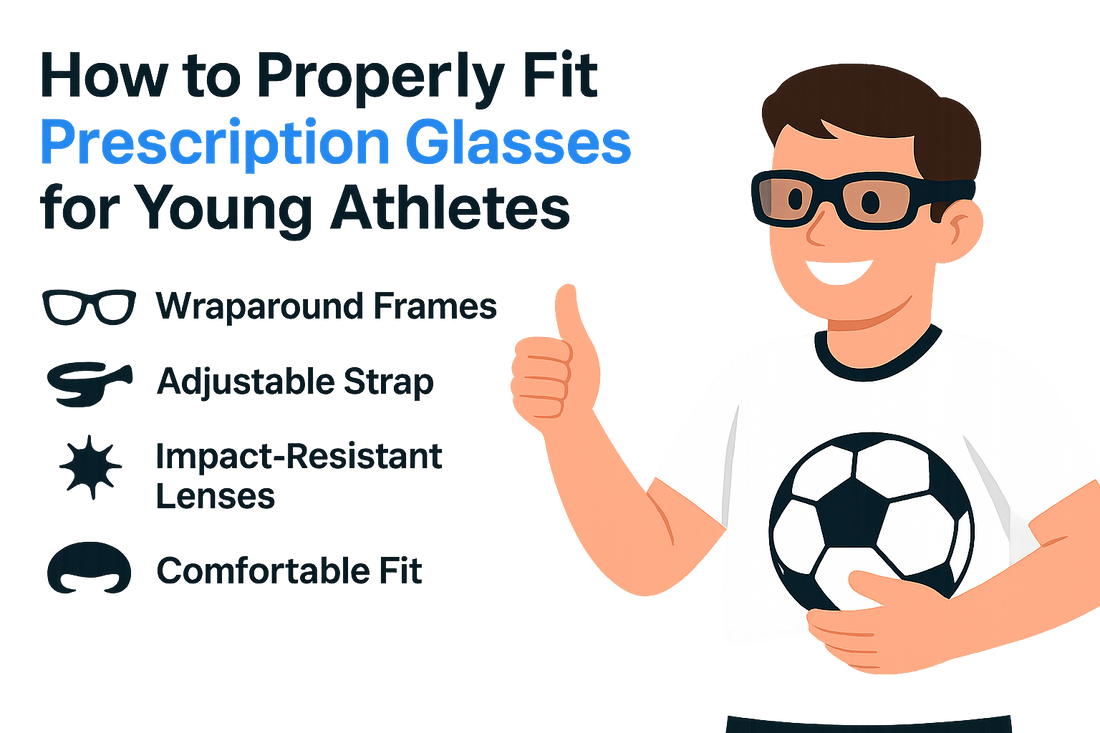
How to Properly Fit Prescription Glasses for Young Athletes
When kids play hard, their eyewear needs to work harder. The right fit keeps prescription glasses stable through sprints, slides, and quick pivots, while helping young athletes see clearly and stay safe. Think of it as part of their gear checklist, right alongside the jersey and cleats 👟. Let’s break down how to get a confident, comfortable fit that can keep up with every game and practice 👓.
Why fit matters for young athletes 🏅
A proper fit does more than stop slipping. It centers the lenses for crisp vision, protects eyes from impact with the right coverage, and prevents pressure points that cause mid-game distractions. For fast-moving sports, glasses that hug the face reduce the chance of bouncing, fogging, and off-axis blur. The result is better focus, more comfort, and a safer day on the field.
Step 1: Measure what matters
Start with a few key numbers so the frames match your child’s face:
- Pupillary Distance (PD): Measure the distance between pupils so lenses align with the visual center. Many parents use a ruler at home or ask an eye care provider to confirm.
- Bridge Width: A bridge that’s too wide slips; too narrow pinches. Look for soft, adjustable nose pads or saddle-style bridges that distribute weight evenly.
- Temple Length: Temples should reach comfortably to just past the ear without digging in. Slight curve helps with grip.
- Frame Width: The front should match face width so lenses sit centered, not stretched or pinched.
Step 2: Pick sport-ready frames
Active kids benefit from frames that are durable, light, and secure:
- Impact-resistant materials: Flexible, tough frames stand up to drops and quick contact.
- Wrapped coverage: Semi-wrap or full-wrap fronts hug the face, boost peripheral clarity, and help block wind and debris.
- Non-slip contact points: Rubberized nose pads and temple tips keep glasses in place as kids sweat.
- Strap compatibility: A detachable head strap adds stability for high-movement play ⚽ and fits well under helmets.
- Helmet friendly: Test with the actual helmet or headgear to ensure temples sit flat and pressure-free.
Step 3: Choose lenses that keep up
Lenses are the performance engine of any pair of sports glasses:
- Material: Polycarbonate or Trivex lenses are light, impact-resistant, and great for active use.
- Coatings: Anti-scratch for durability, anti-fog for humid or fast-paced play, and full UV protection for outdoor sports.
- Tints and options: Grey is versatile for bright sun, amber can enhance contrast for field sports, and photochromic lenses adapt from indoors to outdoors.
Step 4: The try-on checklist
Run through this quick fit test once the glasses are on:
- Frames sit level and do not touch the eyelashes.
- Nose pads contact evenly without pinching or gaps.
- Temples hug lightly with no hot spots behind the ears.
- With a strap, movement is minimal when the child jumps or shakes their head.
- Peripheral vision is clear with no lens edge in the way.
- After 15 minutes of wear, there are no red marks or complaints.
Common mistakes to avoid 🧒
- Buying too big to grow into: Oversized frames slide and misalign the prescription.
- Skipping the strap: Without a strap, glasses can bounce, especially during quick direction changes.
- Ignoring sweat management: Look for rubber grips and venting to reduce fog and slipping.
- Forgetting helmet checks: Always try glasses with the helmet to confirm comfort and stability.
- Using casual fashion frames for sports: Choose sport-specific designs for coverage, impact resistance, and fit.
FAQs
How do I measure my child’s PD at home?
Use a millimeter ruler held at the bridge and measure from the center of one pupil to the other, or ask your eye care provider to confirm for accuracy.
What frame size works best for elementary-aged athletes?
Choose a frame width that matches their face width, with temples reaching just past the ears. Avoid oversized fronts that slip during play.
Can sports glasses fit under a helmet?
Yes. Look for slim, straight temples and test the fit with the actual helmet to ensure no pressure points and steady alignment.
Do lens tints really help in youth sports?
They can. Grey is good for bright sun, while amber or brown can improve contrast for ball tracking on fields and courts.
Why does my child need a strap if the fit is good?
A strap adds extra security during sprints, pivots, and contact, reducing bounce and helping glasses stay centered for clear vision.



